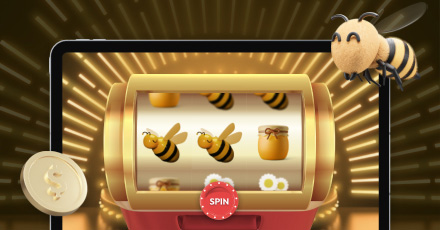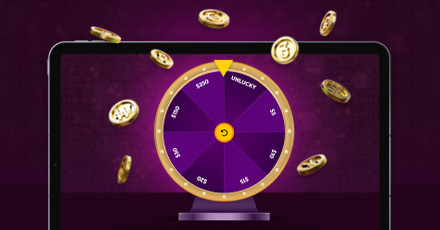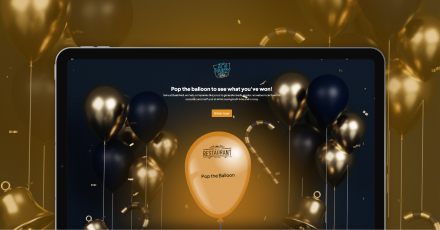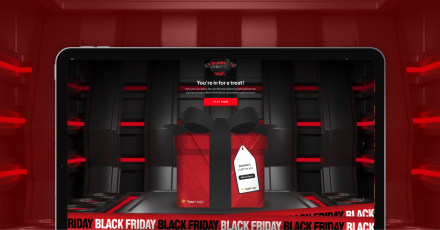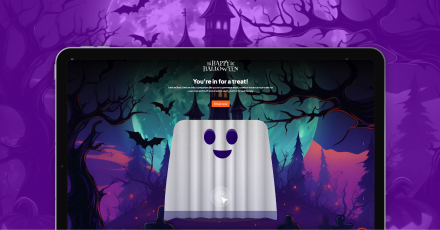Has your opt-in marketing data taken a hit since GDPR rules came in? If it has then you are not alone. We have been working with many of our clients who have suddenly found that their customer data pool has run very dry.

At BeeLiked we prefer to make lemons out of lemonade. Let’s let go of that old, out of date customer information and instead look at invigorating it with a brand new data set, full of enthusiastic, active users. Ready? Let’s go!
What is GDPR?
The phrase “Are you ready for GDPR?” is echoing through corridors at the moment causing much bafflement and unrest, there is a lot of confusion about what it means and how to implement it. There are pages and pages of information out there and if you need to know all the nitty gritty we recommend going straight to the source, at the GDPR portal here but we will touch on a few of the points in this article.
So the EU General Data Protection Regulation (GDPR) is the biggest change to data protection in recent years. Essentially data protection is getting a much needed re-vamp of the existing legislation so that it can now be more relevant in today’s digital, social media driven world. One of the biggest changes is that it gives consumers a better understanding as to what they are signing up to at the point that they can choose to share their data.
Privacy and the use of customer data is a hot topic at the moment with several high profile cases hitting the news recently. With companies such as Uber and Equifax suffering reported data breaches, public faith that personal information is being handled correctly is at an all time low. We see the new changes as an opportunity for companies to be a lot more transparent with customers and diminish the mistrust that their data is being misused.
The ICO (Information Commissioner’s Office) website have clear guidelines below that show how to make the process of consent transparent. These practices should be used as standard for any sign-up forms. If you haven’t implemented this do it today. Any old techniques make your sign up process look out of date and a bit on the dodgy side.
| ASKING FOR CONSENT ✔ ☐ We have checked that consent is the most appropriate lawful basis for processing. ☐ We have made the request for consent prominent and separate from our terms and conditions. ☐ We ask people to positively opt in. ☐ We don’t use pre-ticked boxes or any other type of default consent. ☐ We use clear, plain language that is easy to understand. ☐ We specify why we want the data and what we’re going to do with it. ☐ We give individual (‘granular’) options to consent separately to different purposes and types of processing. ☐ We name our organisation and any third party controllers who will be relying on the consent. ☐ We tell individuals they can withdraw their consent. ☐ We ensure that individuals can refuse to consent without detriment. ☐ We avoid making consent a precondition of a service. ☐ If we offer online services directly to children, we only seek consent if we have age-verification measures (and parental-consent measures for younger children) in place. RECORDING CONSENT ☐ We keep a record of when and how we got consent from the individual. ☐ We keep a record of exactly what they were told at the time. MANAGING CONSENT ☐ We regularly review consents to check that the relationship, the processing and the purposes have not changed. ☐ We have processes in place to refresh consent at appropriate intervals, including any parental consents. ☐ We consider using privacy dashboards or other preference-management tools as a matter of good practice. ☐ We make it easy for individuals to withdraw their consent at any time, and publicise how to do so. ☐ We act on withdrawals of consent as soon as we can. ☐ We don’t penalise individuals who wish to withdraw consent. |
This list seems very reasonable to us but let’s face it, opt in options, tick boxes and data consent info is never going to be sexy or compelling for customers, it won’t be very long before we are all suffering from permission marketing fatigue. So how can you get people to volunteer their precious information and decide that they are happy to opt in? This is where gamification steps in.
What is Gamification?
Gamification is really just a fancy way of using game like qualities outside of actual games. Basically it uses the fun elements associated with games such as winning prizes, or getting a high score to motivate people to do other activities.
This is certainly nothing new, gamification is actually considerably old school, whether it has been putting in a business card in a fish bowl in the hope to win a prize draw or getting the kids to tidy their rooms by making it a competition, each activity is made more exciting by adding in these gamelike elements.
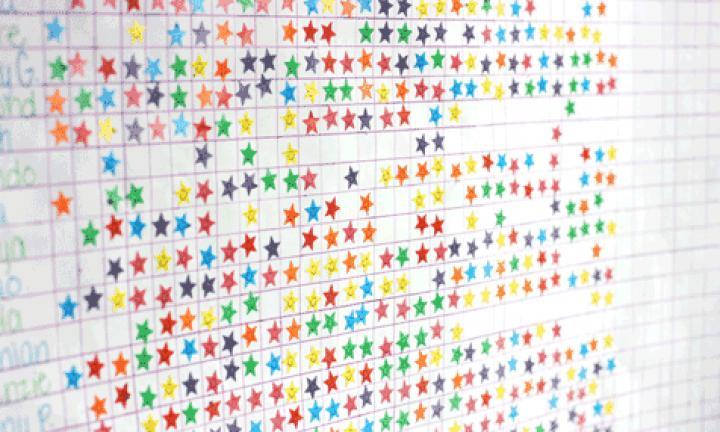
These elements work really well with modern technology, particularly in a world of information overload where we are asked to sign-up to everything, gamification allows the process to be a lot more motivating and rewarding.
How to get users to opt in and sign up?
For those looking to rejuvenate their customer pool, gamifcation has the potential to be win win for all. The key will lie in offering a sufficient incentive for someone to opt in – it needed be big. By creating novel and compelling content as part of the user experience your customers get to enjoy an enhanced experience and have a reason to tick yes.
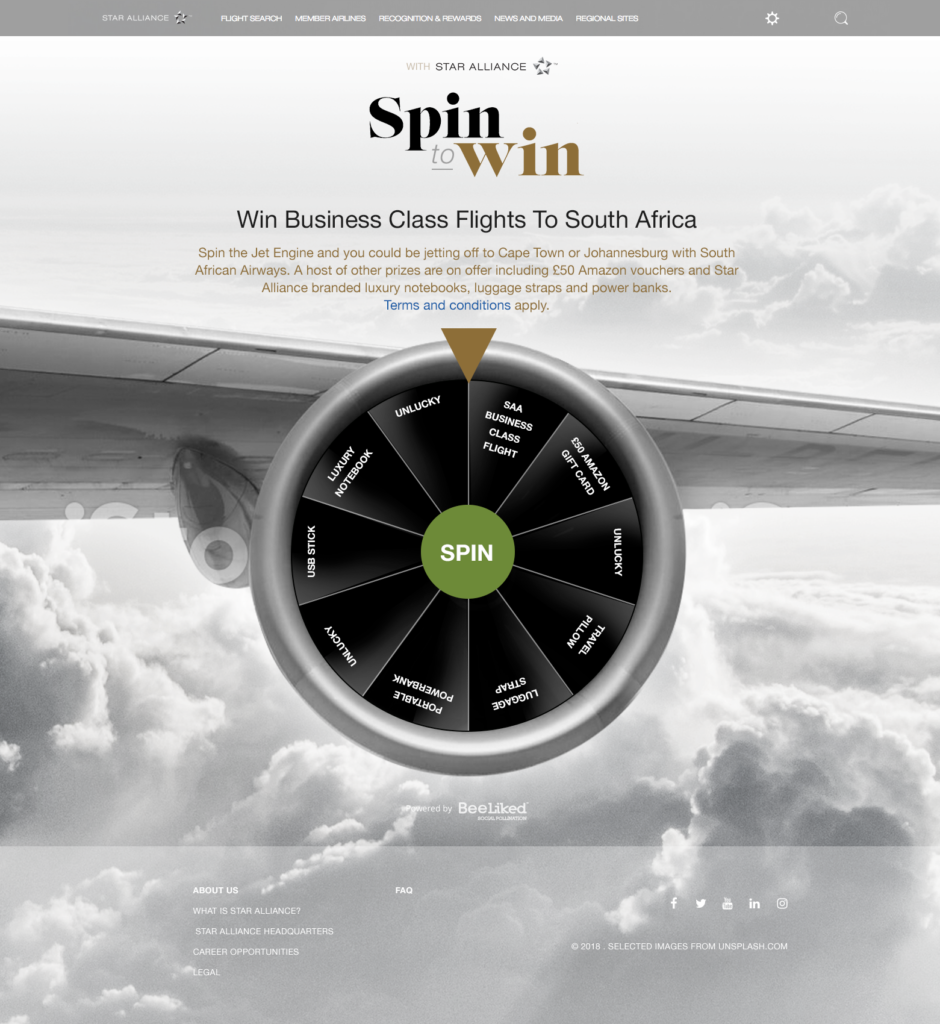
As an example, recently we looked at a campaign for Star Alliance and how we could increase sign up at a trade show. Connecting and networking is an essential part of a trade show/conference and we wanted to look at how we could make this experience as compelling and successful as possible. This was solved by using the Spin the Wheel app on our BeeLiked Platform.
By adding a fun spin wheel, plus the opportunity to win prizes instantly gives the user that extra incentive and a gentle push to sign up.
Other methods of gamification include loyalty schemes. These have evolved tremendously from that punch card you kept in your wallet. Lots of companies use electronic loyalty schemes are a quality source of customer data. By encouraging customers to join in they are given opportunities to gain prizes such as exclusive events or deals, free or discounted products, or a chance to win prizes. Customers can show ‘loyalty’ in many different ways, it could be referring friends, writing a review, or buying a product.
What stops someone signing up?
We have mentioned some of the ways that we can offer incentives to sign up but equally as important are the things that may be putting off your audience, those little red flags that convince users that giving consent will be a bad idea. We spend a lot of time knee-deep in data looking at ways we can improve sign-up performance and here are a few of our tips.
1. You are coming across a little shady
We mentioned before that pre-ticked boxes are out, thank goodness, as well as making someone tick to opt in on one box and opt out on another. Basically anything that looks like you are trying to catch the user out. But there are lots of other ways you may be coming across as untrustworthy. Are you being transparent as possible as to why you want someone to share their data? Are you showing understanding of data protection rules and have you explained if you are sharing with a third party? Are you only asking for the information you really need? Is your wording as clear and upfront as possible?
2. You aren’t giving anything in return
Recently we worked with clients who couldn’t understand why the sign up for one of their campaign was a lot lower than usual. When investigating we noticed that the default text had been used for the newsletter pop up box by mistake. So rather than reading
| Do you want to receive incredible news and epic special offers from xxx? It read Do you want to receive news and updates? |
Just by tweaking the text slightly the incentive for sign up rocketed! We can not underestimate the importance of wording and making the rewards clear!
3. Timing
The other day a pop-up for a survey appeared asking me to answer a few questions about the website, in return I would get my name added to a prize draw. The incentive was there but the timing was off as the box arrived seconds after I had loaded the website. I hadn’t had a chance to look around, let alone have any opinions on it. I cancelled the pop-up and continued looking around, however it did not appear later on after I had browsed when I actually would have been of any help. The customer journey should be a pleasurable experience, not one full of barriers that interrupts or annoys the customer. Think about when the best time would be to offer that discount or to suggest signing up to a contest, one that helps the user.
4. Prizes
A big part of gamification is getting the reward.Your prize says a lot about the audience you wish to attract. You should be offering something that your customers really want and rather than something generic it should be specific to your business. Yes it would be great to win the latest smart phone, gadget or a big pile of money but everyone wants that, so how will this engage the people you want to connect with?
A lot of ‘compers’ tend to search out competitions where they can win prizes that they can then sell on for cash. There are ‘bots’ scanning the internet and looking for such prizes and automatically entering them. If you are looking for a sheer volume of entries then that is fine. However, if you are looking to attract genuine fans, the ones that don’t click unsubscribe at the first given opportunity, then it pays to look at prizes that are more personal to your company or would associate with it and that your audience cares about winning. Perhaps something that money can’t buy, a unique experience, something personalized or signed?
Recently we worked on a contest for John Grisham’s latest book, Camino Island. This campaign was for the Grisham fans, so the prize needed to be something that would be of particular interest to them. Doubleday, a division of Penguin Random House, produced some stunning prizes for the fans: a signed first edition of A Time to Kill from Grisham’s personal collection and a signed collection of all 30 Grisham novels.These rare prizes helped attract the true fans rather than people only interested in winning a prize.
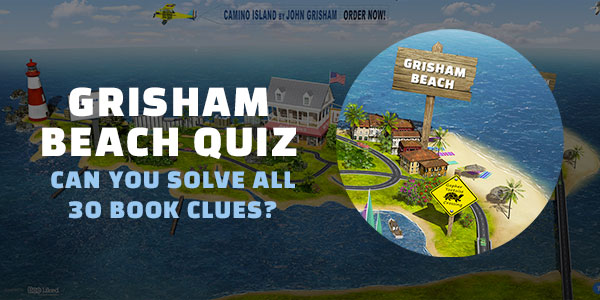
5. The size of the prize
A big flashy prize isn’t always the incentive you might think. Although most people would love to win a new car or an all expenses holiday, it can often seem too unobtainable and people can not imagine themselves actually winning.
If someone thinks that the odds are too slim then they aren’t going to bother entering. Sometimes less is more, smaller prizes can actually attract a large audience as people feel like they have a realistic chance of winning. We often suggest that it might be more successful to have more smaller prizes rather than one big one as an incentive to play.
As a general rule the bigger the prize the harder it can be to enter. You wouldn’t offer big cash prize on a retweet to win competition, as the cost of the prize wouldn’t be worth the results. Having more steps in a contest can help filter out the time wasters and attract the genuine fans. So if you are looking to perhaps collect data or run a survey then you can offer more in return as an incentive.
About BeeLiked
BeeLiked offers companies an ever-growing portfolio of campaign types that are quick to create, with full design flexibility, performance tracking and data collection capabilities to ensure your campaign and promotion exceed all your expectations.
The BeeLiked Platform can help you engage and incentivize your audience and customers across their life-cycle and journey.
BeeLiked is on a mission to prove the ROI of interactive driven marketing. Click here to set up a no-obligation 10-minute discovery call.


